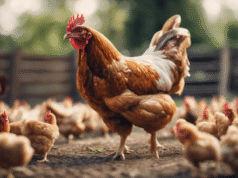Raising chicks is a rewarding experience, but it comes with its own set of challenges. One of the most critical aspects is providing extra warmth for weak chicks. Ensuring that these vulnerable creatures have the right conditions to thrive is essential for their survival and growth. Understanding the needs of weak chicks and how to provide them with the necessary warmth can make a significant difference in their health and development.

Why Do Weak Chicks Need Extra Warmth?
Weak chicks require extra warmth because they are unable to regulate their body temperature effectively. This inability can result from several factors, including being hatched prematurely, having a smaller body size, or suffering from illness. Without adequate warmth, these chicks can become lethargic, fail to grow, and eventually succumb to the cold.
Understanding the Needs of Weak Chicks
Before you can provide the necessary extra warmth for weak chicks, it is crucial to understand their needs. Weak chicks generally have less energy and are more susceptible to temperature fluctuations. They require a stable, warm environment to conserve energy and support their development.
Identifying Weak Chicks
Recognizing weak chicks is the first step in ensuring they receive the care they need. Look for chicks that are smaller, less active, or seem to struggle to keep up with the rest of the flock. These chicks may also have drooping wings or appear fluffed up as they try to retain heat.
Signs a Chick Needs Extra Warmth
It is essential to be aware of the signs that indicate a chick needs extra warmth. These signs include shivering, huddling with other chicks, and a lack of interest in food or water. If you notice any of these behaviors, it’s time to take action to provide additional warmth.
How to Provide Extra Warmth
There are several methods to provide extra warmth for weak chicks. The key is to create a warm and stable environment that mimics the warmth they would receive from a mother hen.
Using Heat Lamps
Heat lamps are a popular choice for providing extra warmth. They emit a consistent heat source that can easily be adjusted to meet the needs of the chicks. Place the lamp over the brooder, ensuring that it maintains a safe distance to prevent overheating.
Heated Mats and Pads
Heated mats and pads offer another effective method for providing warmth. These devices can be placed on the floor of the brooder, offering a gentle and consistent heat source that helps weak chicks maintain their body temperature.
Creating a Warm Environment
Aside from using external heat sources, it is important to create a warm environment. Ensure the brooder is well-insulated and free from drafts. You can also use materials like straw or shredded paper to provide additional insulation.
Caring for Weak Chicks in a Brooder
A clean brooder is essential for the health of weak chicks. Regular maintenance and cleaning help prevent the spread of disease and ensure a hygienic environment.
Setting Up the Brooder
Setting up the brooder correctly is vital for chick health. Ensure that the brooder is spacious enough to allow chicks to move freely but also provides areas for them to huddle for warmth. Use a repurposed drawer or a commercially available brooder to create a safe space.
Maintaining Brooder Temperature
Regularly monitor the temperature within the brooder to ensure it remains within the optimal range for chick growth. This typically means maintaining a temperature of 95F (35C) for the first week, gradually decreasing by 5F weekly.
Providing Nutrition and Hydration
Besides warmth, weak chicks need access to proper nutrition and hydration. Ensure they have constant access to clean water and high-quality chick starter feed to support their growth.
The Importance of Monitoring and Adjustments
Regular monitoring of the chicks and their environment is crucial. Adjust the heat sources as necessary to ensure that the chicks remain comfortable and healthy. Observe their behavior for any signs of distress or discomfort.
Recognizing Improvement in Chicks
As you provide extra warmth and care, you should begin to notice improvements in the chicks. They will become more active, show interest in their surroundings, and start to grow at a healthy rate.
When to Seek Veterinary Help
Despite your best efforts, some chicks may still struggle. If a chick shows no signs of improvement or appears to deteriorate, consult a veterinarian for further assistance.
Conclusion: Ensuring a Bright Future for Your Chicks
Providing extra warmth for weak chicks is a critical component of chick care. By understanding their needs and creating a suitable environment, you can ensure that even the most vulnerable chicks have the opportunity to thrive. With the right care, these chicks can grow into healthy and strong adult birds, contributing to a successful and rewarding poultry experience.

FAQs
1. How can I tell if a chick is too cold?
Chicks that are too cold may shiver, huddle together, or appear inactive. Monitoring their behavior can help you determine if they need extra warmth.
2. Can I use a regular lamp instead of a heat lamp?
While a regular lamp can provide some warmth, a heat lamp is more effective as it provides consistent and adjustable heat, which is crucial for weak chicks.
3. What temperature should I maintain in the brooder?
The brooder should start at around 95F (35C) for the first week, decreasing by 5F weekly until the chicks are fully feathered.
For more information on setting up a chick brooder, you can visit this guide on Backyard Chickens.
This article contains affiliate links. We may earn a commission at no extra cost to you.











